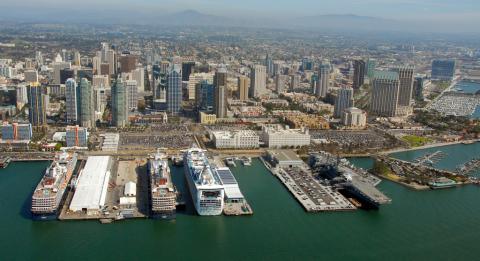Posted January 2019
With an estimated 2017 population of over 1.4 million people, San Diego is the second largest city in California and the eighth largest in the United States. It serves as the seat of San Diego County, the fifth largest in the nation with nearly 3.1 million residents.
The city’s military roots go back to the mid-1800s when the Army constructed artillery batteries along the coast. The Navy established a significant presence in the area in 1901, which expanded over the following decades as numerous bases, training centers, and other facilities were positioned there due, in part, to the city’s strategic coastal location.
As a major hub of military activity, San Diego’s population more than doubled during World War II, increasing from nearly 148,000 to 333,865 residents, and the city’s rapid growth continued through the next several decades as the military fueled the local economy. While the city’s growth continues (with an estimated growth rate of 8.6 percent between 2010 and 2017), it has cooled over the most recent decades, a consequence, in part, of national defense spending cuts.
According to recent Census estimates, San Diego is 59 percent white, 16 percent Asian, 7 percent black, 5 percent “two or more races,” and 12 percent “other.” Twenty-nine percent of the population identify as Hispanic or Latino. With more than a quarter (27 percent) of its population being foreign born, and with over 40 percent speaking a language other than English at home, San Diego is now considered to be one of most diverse cities in the nation.
However, considerable inequities exist between the city’s racial groups. For instance, in 2016 median incomes for both white and Asian families were above $80,000, while median incomes for black and Latino families were about $53,000. Similarly, 7 percent of white children lived in poverty, compared to about 25 percent of all black and Latino children.
With the nation’s fourth largest homeless population, lack of affordable, accessible housing is another serious problem affecting the city. In particular, the region has one of the highest rates of homeless veterans, homeless individuals, and unsheltered homeless families in the nation.
Working to address these challenges are a range of community wealth building organizations and initiatives such as Solutions for Change, a nonprofit that created a leadership development residential program for homeless families with supportive housing, life skill training, workforce development, counseling, health services, and youth-focused programming. To help fund its services while providing training and employment opportunities for its program participants, Solutions for Change also operates social enterprises, including New Solutions Housing (multifamily property management and maintenance services), New Solutions Real Estate Development (housing construction), and Solutions Farms (an aquaponics farm growing sustainable produce).
As the San Diego region is considered one of the country’s most productive agricultural areas, it's not surprising that many of the city’s community wealth building initiatives aim to increase access to affordable, healthy, local food. For example, Kitchens for Good rescues surplus and cosmetically imperfect food from wholesalers and farmers and runs a culinary apprenticeship initiative that uses rescued ingredients to create nutritious meals for food-insecure families. One particularly exciting nascent effort is Project New Village’s Good Food District, which aims to support urban agriculture, neighborhood-based agricultural cooperatives, arts and culture, and other wealth building strategies to promote community revitalization and place making, and help transform the political and economic environment.
An overview of these and other exemplary community wealth building efforts follows:

